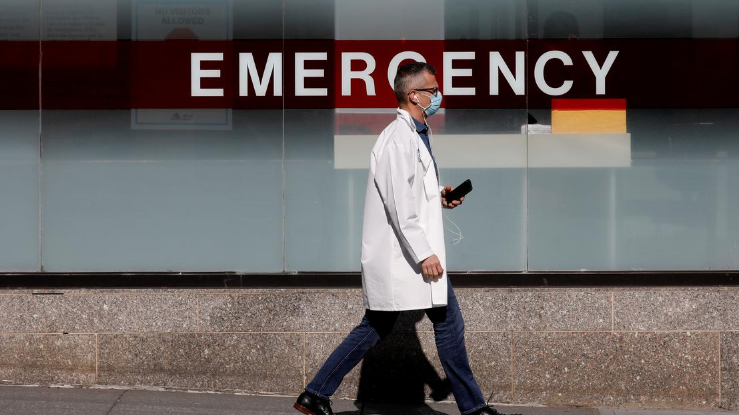
A doctor wears a protective mask as he walks outside the Mount Sinai Hospital in Manhattan during the COVID-19 outbreak in New York City, New York, the U.S., April 1, 2020. /Reuters
**Editor's note: **Jiang Shixue is a professor at the Institute of Global Studies at Shanghai University. The article reflects the author's opinion, and not necessarily the views of CGTN.
The COVID-19 pandemic has causedgreat damage worldwide. As a result, many people start to envisage that, when the pandemic is over, the world will never be the same. What will happen?
Myth 1: COVID-19 virus is the last straw that will break the back of economic globalization.
It is true that, in order to stop the spread of the virus, many countries have taken several tough measures in order to limit or even halt the movement of people both domestically and internationally. The U.S.was the first country to ban the entry of peoplewho have recently traveled to China starting early February.
However, it should be understood thatfreedom of movement will certainlyresume as soon as the virus is completely contained globally.
Global value chains (GVC), one of the most important hallmarks for economic globalization, are broken nowadays as movement of goods is also negatively affected by various measures put in place to contain the virus. However, GVC will surely re-establish itself when these measures are lifted in the post-COVID-19 era.
As Chinese President Xi Jinping remarkedat the World Economic Forum in Davos in early 2017, "From the historical perspective, economic globalization resulted from growing social productivity, and is a natural outcome of scientific and technological progress, not something created by any individuals or any countries."
Though social productivity and scientific and technological progress are faced with hardships today, in the longer run, they will continue to proceed steadily, boosting economic globalization in a business-as-usual manner.
Myth 2: COVID-19 will turn the world order upside down.
The current world order is composed of two parts: a multilateral world order and a liberal world order. Despite the great damagecaused by the COVID-19 pandemic, neither part of the world order today is likely to undergo significant transformation.
The multilateral world, built upon the UN Charter and multilateralism and supported by many countries in the world, represents a historical trendtowards world peace and development. Therefore, it will not be destroyed by the COVID-19. On the contrary, the struggle against the virus indicatesthat international cooperation and mutual respect, cornerstones of the multilateral world order, areurgently needed.

An emergency medical technician moves a patient to an ambulance to the New York-Presbyterian Lower Manhattan Hospital in New York, the United States, April 15, 2020. /AP
According to Wang Yi, China's foreign minister, China is one of the founders and guardians of the current international system and world order. What he meant is certainly a multilateral world order.
Though the liberal world order, equivalent to Pax-Americana, some argue is losing its luster, it will not be stopped by the pandemic. First of all, having dominated the world for so many decades, the liberal world order has become more and more resilient; secondly, despite the claim that the West is faced with what the Munich Security Conference described as "westlessness," it continues to be supported by the West; and finally, the U.S. is still the only superpower in the world.
As the current world order will remain almost the same, the confrontation between the multilateral world order and the liberal world order will be intensified in the post-COVID-19 era.
Myth 3: COVID-19 pandemic will end the "American century"
In the history of mankind, the world has always been dominated by one or a very small number of countries. The "American century"simply means that, for more than a century, the U.S. outstrips its closest rivals in hard and soft power.
Indeed, with the rise of China and other emerging economies, the relative power of the U.S. is becoming weakerand weaker. That is why President Trump wishes to "make America great again."
Moreover, President Trump's efforts to fight against the COVID-19 is certainly a failure. However, it does not meanthat the "American century"will be doomed by the COVID-19. The U.S. military strength remains the same although many sailors aboard their aircraft carriers were hit hard by the virus. The U.S. economy will suffer from a negative growth rate, but almost every economy in the world will fall into recession.
To put it another way, the COVID-19 pandemichas weakened the hard power of every major country in the world, and no country can claim a victory. Therefore, the equation of balance of power of the world in the near future is unlikely to be changedin a major way.
But the U.S. should not be complacent. It has the largest number of confirmed cases of infections. It has threatened to punish the World Health Organization so as to find a scapegoat for its inability to manage the health crisis. Therefore, its international image as a super power has been greatly tarnished.
In conclusion, when we predict the post-COVID-19 era, we should be realisticabout what may come next. The world will certainly go through some changes but the economic globalization is going to continue, the world order is here to stay as well and the U.S. will remain the most powerful country in the world still in the foreseeable future.
(If you want to contribute and have specific expertise, please contact us at [email protected].)
 简体中文
简体中文

